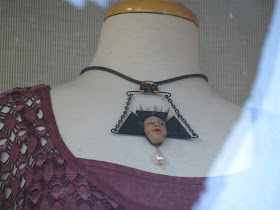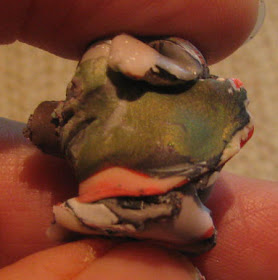
I'm sure some of you feel the way I do after presenting my work - it's the most unpleasant part of the creative process!!! I'm exhausted and unsettled even though things went extremely well and most of the collection was accepted and even applauded (I've included a couple of pictures from their window display). I guess that's why many artists have agents. That having been said, I recognize the need for good marketing strategy and, yes, I want my work to be seen, and it does feel wonderful when someone appreciates a piece to the point where they will pay to own it.
So with that in mind, let's talk a bit about how to "value-add" to the actual work of art.
Selling the Sizzle
My husband was a marketing executive. Early in his career his boss took him out for lunch. The first steakhouse they came to was known for its excellent food and there were several people inside, enjoying lunch. They walked on to a second steakhouse which also had a good reputation. Here the steaks were cooked in a glassed-in area so the chef was visible to both the diners inside and people passing by on the street. The place was packed. His boss asked, "What's the difference? Both have great steaks." He then dropped this gem: "The first place sells great steaks. This one sells great steaks and it also sells the sizzle!"
This powerful lesson has been translated into the marketing of my art, both paintings and jewelry.
The key is The Story - the story behind the birth of the piece..... the story about the artist..... the story about the process itself. People enjoy hearing about these stories, and so often, when purchasing a work of art, the buyer is also buying a bit of the artist. Knowing what led the artist to make that particular piece, knowing a bit of the history of the artist, her/his quirks, foibles, needs, knowing a bit of the process of the creation or of the material from which it's made, this gives the buyer inside information that she/he can share with those who notice their purchase. It's called "selling the sizzle". It makes the piece more than just a visual experience. It enlarges it, giving it history, connections, reasons for being, even an aura of mystery with hints of even more to know.


How to value-add? One simple but very effective way is to include a little write-up about the piece with the piece. For example, each of the pieces in this collection has a specific, personalized write-up, including the name of the piece as well as a bit of background on the medium itself and on the experience of the artist (me). At the back of the little folder I have cut two slits so I can insert my business card. Not only does this give the potential buyer "the story", but it makes it easier and more interesting for the sales staff to present the piece to their shoppers. Furthermore, it becomes a more interesting item to buy as a gift for someone else.
Mine are all handmade. The inside is printed on my printer for easier reading, but each is personalized to the specific piece of jewelry. This is a choice I've made (over having it professionally produced) because of my feelings about "the mark of the artist", discussed in an earlier post. That's why I also make my own clasps to the extent possible. I want as much of each piece to be handmade by me as can reasonably be done.
So I encourage all of you to consider "selling the sizzle" along with your art.
Now let's talk pricing. Another unpleasant facet, but necessary and therefore dealt with. I decide how much I need to get out of the piece including material cost and reasonable labor costs. I don't include prototyping because that is very time consuming and the most enjoyable part of the process for me. Coming up with a new creation, whether a new technique for surface veneer or new shapes or new connections is what I love to do and would do over and over and over again. Having made the prototype (and having worn it to make sure I have worked out all the kinks) I then make a second. That gives me a realistic idea of how much time is involved. On that basis I work out a reasonable wholesale price, then double it and look at it from the standpoint of whether I, as a buyer, would consider spending that amount of money to acquire that specific piece. If it is way too high, I look at ways I can change the production of it to make it more reasonable. If it is not possible to do that, I don't make any more of that type of art.
It is important to differentiate between one-of-a-kind and reproducible pieces. I have chosen to position myself as a one-of-a-kind artist and as such I charge more for my work. I'm willing to put myself into a smaller buyer pool, knowing that, in time, my work will prove itself unique, interesting, well-made, and that this reputation is what will fuel future purchases.

























